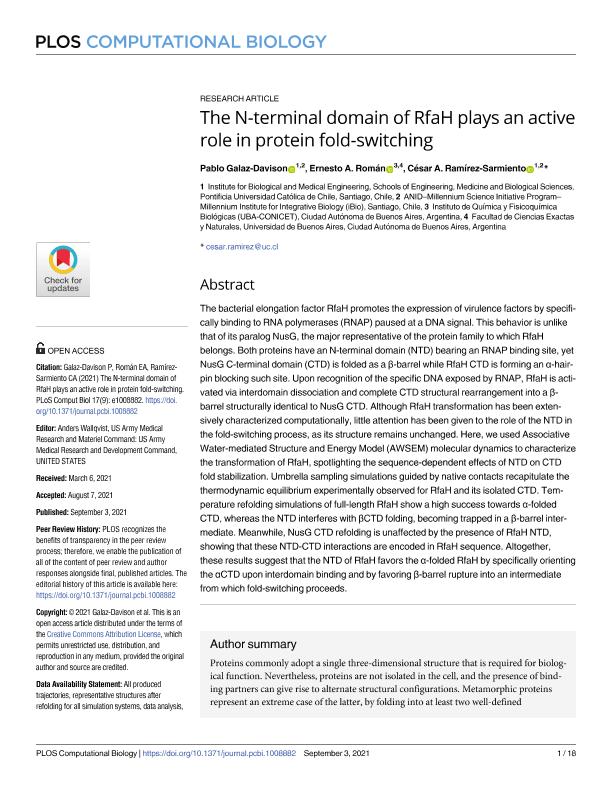Mostrar el registro sencillo del ítem
dc.contributor.author
Galaz Davison, Pablo
dc.contributor.author
Roman, Ernesto Andres

dc.contributor.author
Ramírez Sarmiento, César A.
dc.date.available
2022-10-14T10:45:11Z
dc.date.issued
2021-11
dc.identifier.citation
Galaz Davison, Pablo; Roman, Ernesto Andres; Ramírez Sarmiento, César A.; The N-terminal domain of RfaH plays an active role in protein fold-switching; Public Library of Science; Plos Computational Biology; 17; 9; 11-2021; 1-18
dc.identifier.issn
1553-734X
dc.identifier.uri
http://hdl.handle.net/11336/173135
dc.description.abstract
The bacterial elongation factor RfaH promotes the expression of virulence factors by specifically binding to RNA polymerases (RNAP) paused at a DNA signal. This behavior is unlike that of its paralog NusG, the major representative of the protein family to which RfaH belongs. Both proteins have an N-terminal domain (NTD) bearing an RNAP binding site, yet NusG C-terminal domain (CTD) is folded as a β-barrel while RfaH CTD is forming an α-hairpin blocking such site. Upon recognition of the specific DNA exposed by RNAP, RfaH is activated via interdomain dissociation and complete CTD structural rearrangement into a β-barrel structurally identical to NusG CTD. Although RfaH transformation has been extensively characterized computationally, little attention has been given to the role of the NTD in the fold-switching process, as its structure remains unchanged. Here, we used Associative Water-mediated Structure and Energy Model (AWSEM) molecular dynamics to characterize the transformation of RfaH, spotlighting the sequence-dependent effects of NTD on CTD fold stabilization. Umbrella sampling simulations guided by native contacts recapitulate the thermodynamic equilibrium experimentally observed for RfaH and its isolated CTD. Temperature refolding simulations of full-length RfaH show a high success towards α-folded CTD, whereas the NTD interferes with βCTD folding, becoming trapped in a β-barrel intermediate. Meanwhile, NusG CTD refolding is unaffected by the presence of RfaH NTD, showing that these NTD-CTD interactions are encoded in RfaH sequence. Altogether, these results suggest that the NTD of RfaH favors the α-folded RfaH by specifically orienting the αCTD upon interdomain binding and by favoring β-barrel rupture into an intermediate from which fold-switching proceeds.
dc.format
application/pdf
dc.language.iso
eng
dc.publisher
Public Library of Science

dc.rights
info:eu-repo/semantics/openAccess
dc.rights.uri
https://creativecommons.org/licenses/by-nc-sa/2.5/ar/
dc.subject
RfaH
dc.subject
fold-switching
dc.subject
RNAP
dc.subject
AWSEM
dc.subject.classification
Otras Ciencias Naturales y Exactas

dc.subject.classification
Otras Ciencias Naturales y Exactas

dc.subject.classification
CIENCIAS NATURALES Y EXACTAS

dc.title
The N-terminal domain of RfaH plays an active role in protein fold-switching
dc.type
info:eu-repo/semantics/article
dc.type
info:ar-repo/semantics/artículo
dc.type
info:eu-repo/semantics/publishedVersion
dc.date.updated
2022-09-22T11:44:30Z
dc.journal.volume
17
dc.journal.number
9
dc.journal.pagination
1-18
dc.journal.pais
Estados Unidos

dc.journal.ciudad
San Francisco
dc.description.fil
Fil: Galaz Davison, Pablo. Pontificia Universidad Católica de Chile; Chile. Universidad Católica de Chile; Chile
dc.description.fil
Fil: Roman, Ernesto Andres. Consejo Nacional de Investigaciones Científicas y Técnicas. Oficina de Coordinación Administrativa Houssay. Instituto de Química y Físico-Química Biológicas "Prof. Alejandro C. Paladini". Universidad de Buenos Aires. Facultad de Farmacia y Bioquímica. Instituto de Química y Físico-Química Biológicas; Argentina
dc.description.fil
Fil: Ramírez Sarmiento, César A.. Pontificia Universidad Católica de Chile; Chile. Universidad Católica de Chile; Chile
dc.journal.title
Plos Computational Biology

dc.relation.alternativeid
info:eu-repo/semantics/altIdentifier/url/https://journals.plos.org/ploscompbiol/article?id=10.1371/journal.pcbi.1008882
dc.relation.alternativeid
info:eu-repo/semantics/altIdentifier/doi/http://dx.doi.org/10.1371/journal.pcbi.1008882
Archivos asociados
